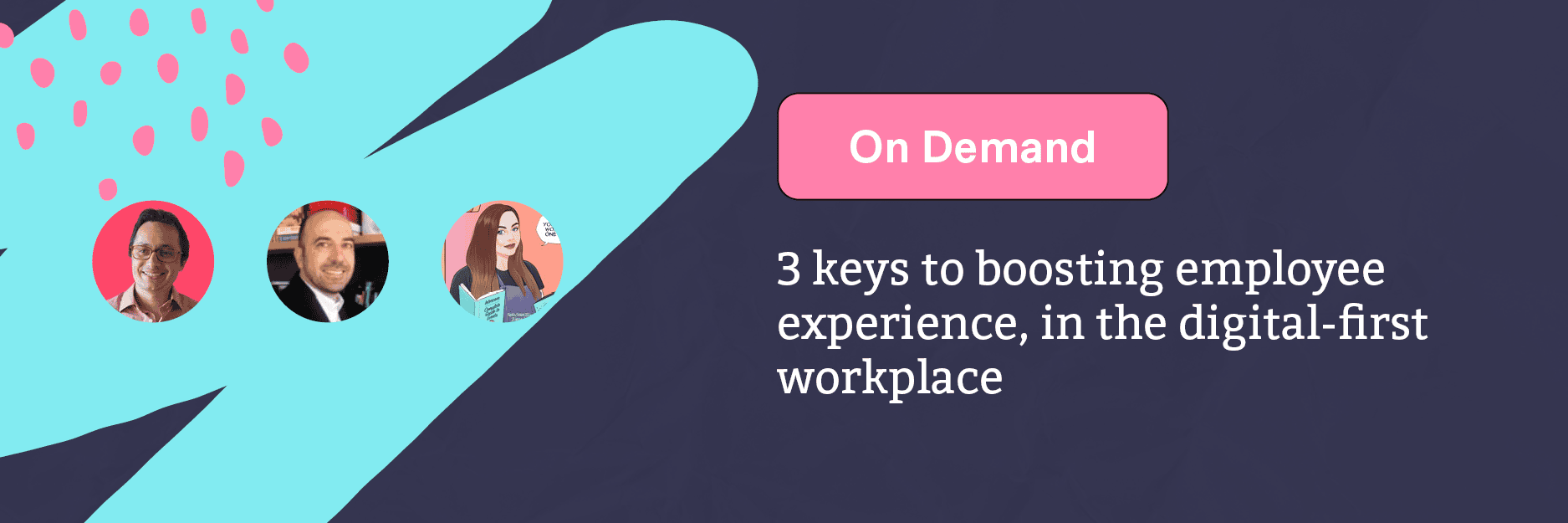Rethinking the Digital Employee Experience to Future-Proof Your Hybrid Workplace

Barry Nyhan
Senior Demand Gen & Marketing Ops
15 Jun 2021
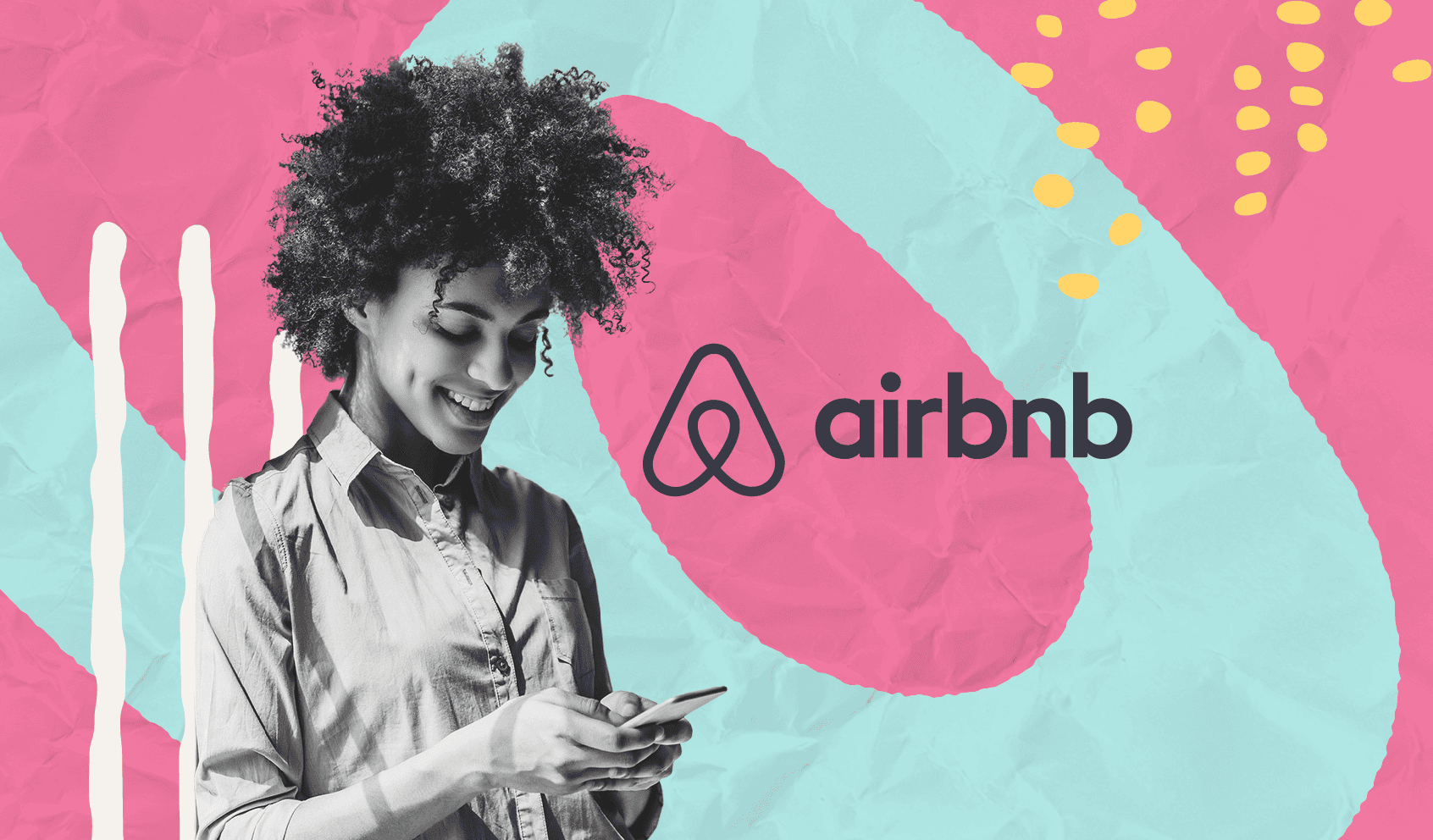
We have to rethink what kind of digital employee experiences we will have in our workplaces, and that starts with the culture we cultivate.
The workplace has changed over the course of the pandemic, and one thing is becoming clearer: the shift to hybrid work is here to stay.
As the world begins to reopen, businesses need to reimagine what they want their working environment to look like. Workers that have experienced remote work now want it to stay, and companies are trying to adjust to a new normal—creating productive, meaningful workplaces in hybrid environments.
Yet hybrid workplaces come with their own set of challenges.
When workers rely on technology instead of human interactions, it can easily become a cold, frustrating experience. Tools that aim to connect humans often miss a core ingredient of what workers crave: a space to build meaningful relationships and have their voices heard.
It’s time to rethink what kind of digital experiences our employees will have in our workplaces—and that starts with the tech stacks we use and the culture we cultivate.
What is the digital employee experience, and why is it important?
The digital employee experience refers to any time employees use technology to communicate and collaborate as part of their role at a company.
When talking about digital employee experiences, we must recognize that this applies to every single person in your business, not just those who work in the IT department. Digital experiences can be anything from sending emails to jumping on a video call to giving feedback on a project.
Companies are starting to wake up to just how important the digital employee experience is for their teams and their brand.
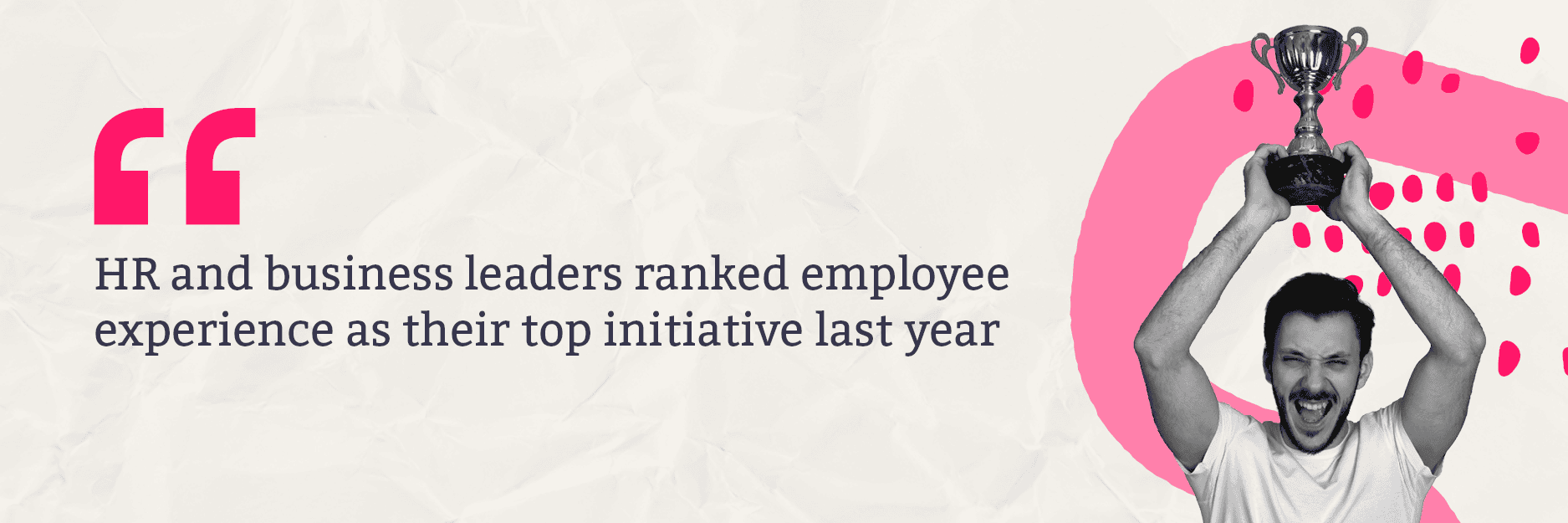
HR and business leaders ranked employee experience as their top initiative last year. And with 64% of the global working-age population estimated to be Millennial and Gen Z workers by 2025, seamless digital experiences are no longer just “nice-to-have”… employees demand them. That’s because, for workers, digital experiences go beyond emails and collaboration. These platforms are a portal to understanding and discussing company culture and foster a sense of belonging and equity.
Reimagining the digital employee experience cannot happen if we only look at technology as a way to get work done. We must look at them differently because digital platforms can add more to our employees’ lives. They are a way to interact socially, build deeper relationships, and break down the silos between workers and management.
How does the digital employee experience help you engage employees at work?
Engaging employees at work needs to go beyond measuring productivity and KPIs.
Studies show over and over again that businesses that have engaged employees are more successful. 71% of executives told Harvard Business review that employee engagement is critical to their company’s success, and a University of Pennsylvania’s Wharton School study made a direct link between employee engagement levels and how competitive companies are.
Engaged employees are also resilient. Gallup researchers found that highly engaged teams were more resilient during the 2001/02 and 2008/09 recessions compared to their peers.
Rethinking how you use technology in your workplace means breaking down some of the unwritten rules around digital processes. If we can finally let go of bad technology and replace it with newer, more productive technology, it can revolutionize our workflows.
Think about how businesses traditionally engage their employees at work. How do they do it? They might send out a mass email to make an announcement. Or maybe they bring everyone into a conference call that only they speak on.
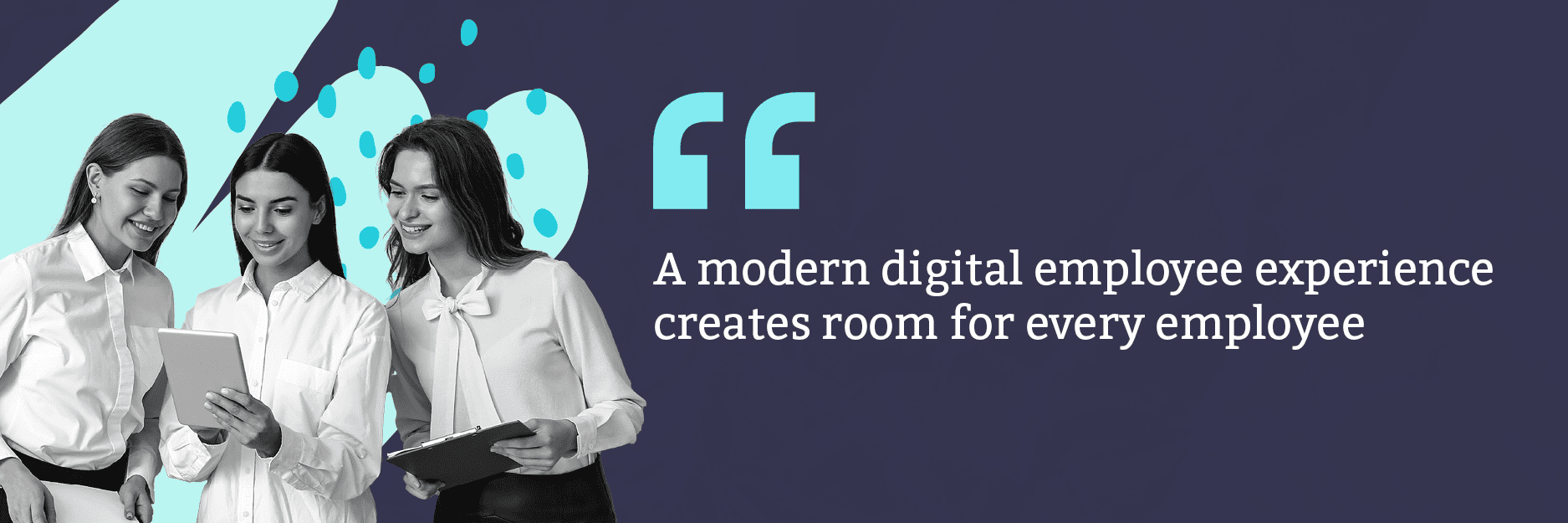
We must reimagine how we can make hybrid workplaces more equal, so employees feel like they have a voice. A modern digital employee experience creates room for every employee, from the bottom to the top, to discuss cultural issues, encourage innovation, and interact with their teammates.
Three tips for creating an engaging digital employee experience
1. Foster a sense of connection and belonging in the workplace
If employees don’t feel like they belong at your company, their work performance drops, and they might even start looking for another job.
When nearly 1800 employees were asked how important a sense of belonging in the workplace was, the results were eye-popping. People who felt a strong sense of belonging to their workplaces had a:
???? 56% increase in job performance
???????? 50% reduction in turnover risk
???? 75% decrease in sick days
The researchers said that up until now, workplaces lacked tools to create inclusive, engaging workspaces.
To overcome this, it recommended teams focus more on fostering better connections and encouraging employees to think about how to be more inclusive.
This work can be done whether your team is in an office or working remotely—if you’ve got the right tools. Digital workplaces give teams a space to work together and build connections. They’re a place where employees can share stories and get to know each other, even if they’re behind a screen.
2. Create meaningful human connections
People connect with the business they work for in two ways: through its employees and its goals.
When Deloitte took a deep dive into how businesses could create connections within their workforces, they discovered the most important factors were organizational culture, leadership behaviors, and employee relationships.
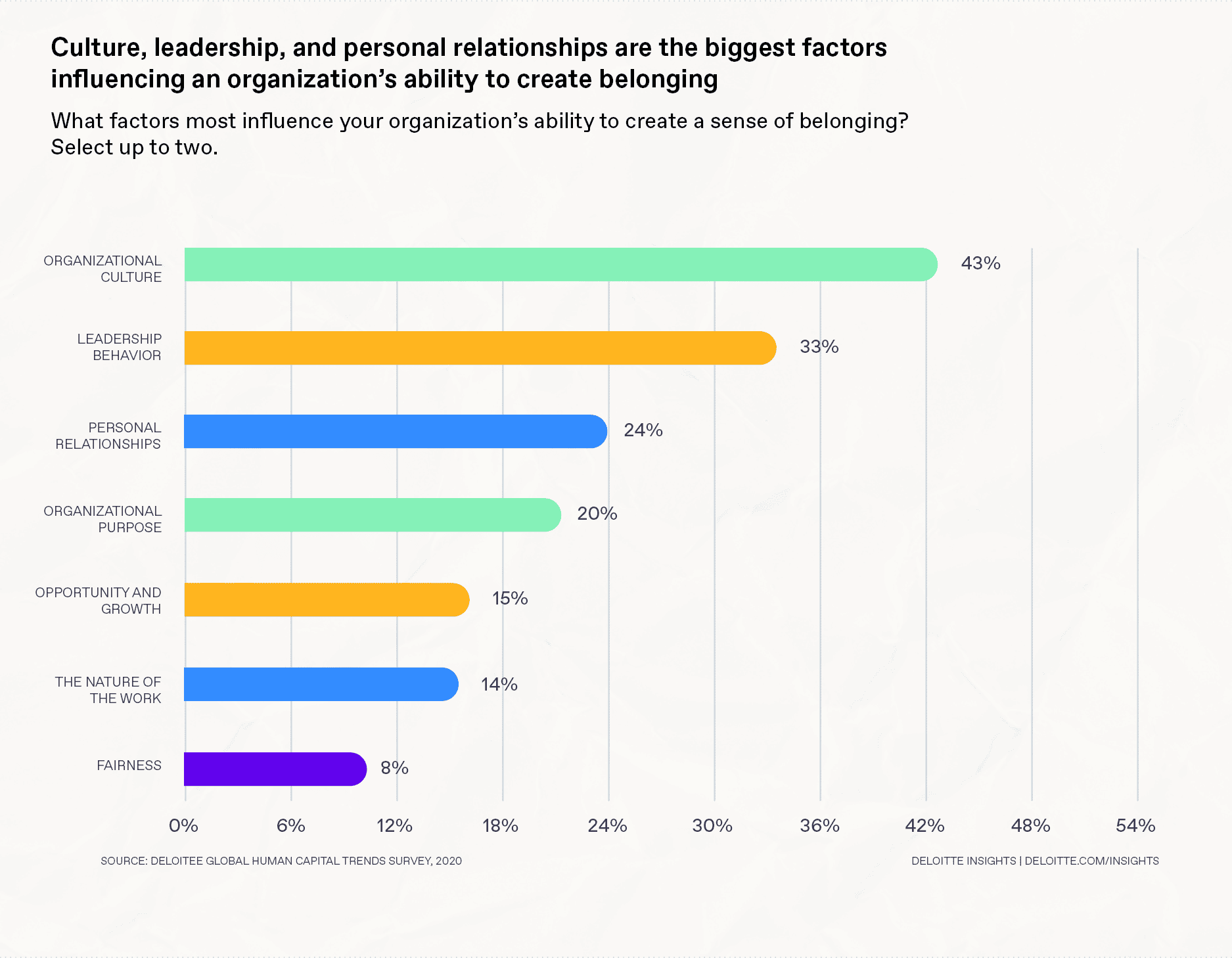
The good news is that businesses can tap into all three of these factors by challenging how we traditionally empower employee connections.
With 1,700 staff and a traditional communication structure, Staffordshire University knew it had to find a new way for its employees to engage and build connections on (and off) campus.
“People really do want to collaborate, they want to talk to their colleagues, they want to work together,” Julie Waddicor, Head of Communications, said.
“That’s not always easy in a traditional structure.”
So, it invested in a digital employee platform that staff could use to showcase their work and talk to their colleagues. Staffordshire University now have a central platform, Workvivo, which they use to discuss projects, work towards common goals, and give shout outs to other team members.

“Workvivo is a real link between employees on a level that we didn’t have before, and it gives us a cultural platform that we were missing.”
Julie Waddicor - Head of Communications, Staffordshire University
3. Building equity so every employee feels included
Hybrid workplaces bring an unusual problem for managers: how can they keep everything equal when some employees are working from the office, and others are working from home?
It’s easier to make every employee feel included if you can physically see them and involve them in discussions. But hybrid workplaces must think outside the box and create a digital employee experience that’s equal to everyone, no matter where they’re working from.
This was a problem that BetterUp CEO Alexi Robichaux faced with his hybrid team. Although the company encouraged remote work, all of its meetings were held in their San Francisco office, excluding remote workers.
“We started creating remote weeks when the whole company goes remote in order to build empathy about what it’s like to be the person on the Hangout,” Robichaux said.
During these weeks, Robichaux realized that some of the meeting activities actually excluded people joining remotely. This awareness helped the company change the structure of the meetings so no matter where employees were attending from, the meetings were equal.
“Sharing experience is a great fuel for empathy,” Robichaux says.
If your entire team is working remotely, there can still be inequality within their digital experiences. Make sure your team is engaged wherever they may be working and look for feedback to boost your employee experience moving forward.
Want to learn more about digital employee experience? Join Airbnb, Intercom, and Workvivo for a webinar on how to prepare your company for the next decade here.
